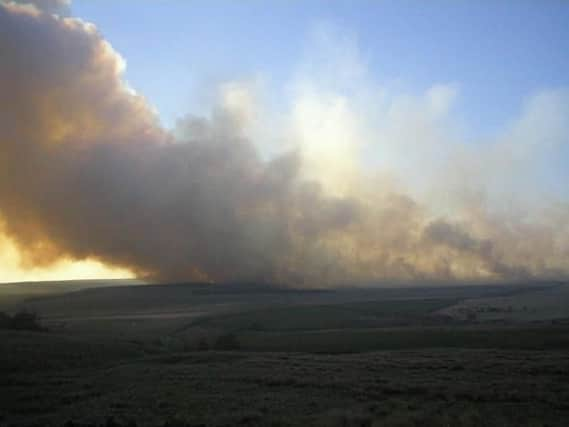Warning over Lancashire wildfires risk


In the latest incident, firefighters in Chorley were called out to a wildfire in Rivington, near Green Lane, on Thursday evening. Crews spent nearly an hour extinguishing the 100m wide fire with beaters.
In the last three years, fire crews in Lancashire have attended 82 incidents involving wildfires and firefighters fear that the county is at risk of a major fire.
Advertisement
Hide AdAdvertisement
Hide AdExperts say that the cyclical nature of wildfires means that Lancashire is ripe for another major incident, which would tie up vital resources across the county.
In 2011, firefighters spent a week battling a fire that raged across Anglezarke Moor. At its peak more than 100 firefighters and 23 engines were called out. #
Fire Services say that the fire, which started on April 29, devastated several square kilometres of moorland and took nine days to fully extinguish.
Fire bosses are now warning members of the public to take extra care around moorland as the weather warms up and we enter a peak season for grass fires.
Advertisement
Hide AdAdvertisement
Hide AdCounty firefighter Shaun Walton, who is chairman of the National Fire Chief’s Council Wildfires Group, said: “The moors are particularly vulnerable to wildfires in spring.
“Grass dries out over the winter months and by the spring it can become tinder dry. New grass grows in June but by August and September the grass dies off again posing another seasonal risk. These fires take a significant amount of resources to tackle and take away crews who could be attending other incidents.
“The peat moorlands around Lancashire pose a particular risk as the peat effectively acts as fuel. Fires can burn down to the bedrock devastating local wildlife. There is also a significant impact on infrastructure as roads around the fires often have to be closed due to smoke which in turn, negatively affects the economy.”
Firefighters say the main causes of fires on the moorlands are discarded cigarettes, barbecues, arson and even hot exhausts on cars.
Advertisement
Hide AdAdvertisement
Hide AdShaun added: “As firefighters we would never advise anyone to use a barbecue on the moors, but if you do please make sure it is properly extinguished and cool before disposing of them. Make sure they are used in an area where the fire is unlikely to spread.
“We also have a lot of issues caused by smokers. Discarded cigarettes can cause the moors to go up in flames as the grass is tinder dry.
“Even an exhaust on a car can cause a fire if it is hot enough. If you see a fire on the moors always dial 999 and ask for the fire service. Try to give us a precise location for the fire if you are able – a grid reference, or landmark or road name.”
Fires have previously caused massive devastation to local wildlife and species such as the Large Heath butterfly have been largely depleted as a consequence of moor fires, say local wildlife experts.
Advertisement
Hide AdAdvertisement
Hide AdDavid Dunlop, Senior Conservation Officer at The Wildlife Trust for Lancashire, Manchester and North Merseyside said: “Wildfires are increasingly problematic during prolonged spells of warm and dry weather, particularly at weekends and public holidays.
“Our moors and mosses are particularly prone to the impacts of deliberate fire-setting or carelessness, especially where the impacts of past drainage mean that they are not able to retain water from winter rainfall as well as they would naturally. Coastal scrub, heath and grassland may also become tinder-dry.”
Warning over arson attacks
Fire services in Lancashire saw an increase in the number of arson attacks on homes last year, Home Office figures show.
In the 12 months to September 2017, the Lancashire Fire and Rescue Service attended 113 deliberately started house fires, 14 per cent more than the previous year. Since 2013, five people have been killed in arson attacks.
Advertisement
Hide AdAdvertisement
Hide AdBut Lancashire fire chiefs added that recent trends show a fall in arson attacks.
Spokesman Richard Edney said: “The report you have does show an increase and the causes of the arson fires that we attended are usually insurance fraud, domestic violence, mental health and substance abuse.
“Our firefighters who are supported by our accredited fire investigators have more experience and knowledge for detecting deliberate fires.”
Dave Green, national officer at the Fire Brigades Union, said: “Starting fires deliberately in the home is a heinous crime. Rightfully, it is a serious criminal offence punishable by law.
Advertisement
Hide AdAdvertisement
Hide Ad“Arsonists do not just put the immediate victims at risk; they put whole communities and firefighters themselves in jeopardy.
“The fire and rescue service is already stretched to the limit.If firefighters are dealing with an arson when another fire call comes in, then those other victims are looking at a long wait.”